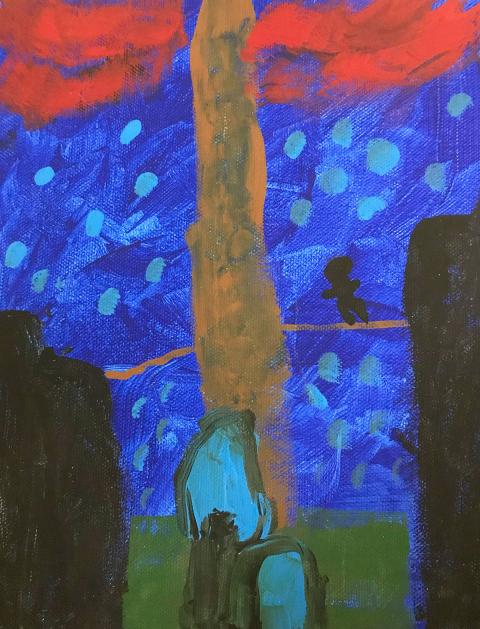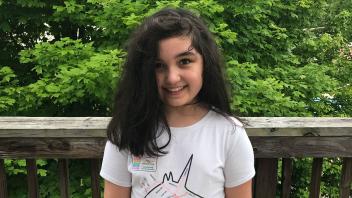When 12-year-old Ariana Ferogh starts a book, she has to jump to the end to make sure that everything will turn out okay. Once she knows that, she can return to page one and enjoy the ups and downs of how the characters arrive at the story’s resolution. She’s an ardent reader, but she has a difficult time with injustice. Seeing what she reads like a movie in her head, Ari can get angry with characters when they act mean or jeopardize the rights of other characters … so much so that sometimes she has to put a book down for days, even weeks in order to work through those intense feelings on her own.
Being passionate about helping others and striving to make the world a better place are integral parts of who Ari is. Being autistic is another integral part.
Hear Ari, who wants to be a pharmacist when she grows up, describe what being autistic means for her and what fictional characters she loves.
The autism spectrum: more circular than wide
When Ari was one day old, she was diagnosed with a heart condition and much of her infancy and toddlerhood were focused on that; missed milestones and developmental differences were often attributed to her medical issues. It wasn’t until her parents, Chloe and Sal Ferogh, enrolled her in a dance class as a 4-year-old that they understood that she was wired differently from other children her age. Ari had been a very late talker but an extremely early reader, starting both around 2-3 years old. By the end of kindergarten, she was diagnosed with educational and medical autism.

“Educational and medical autism diagnoses do different things. A medical diagnosis opens the door to medical/therapeutic supports outside of school while a finding of educational autism means that the student meets the criteria and that the presentation of autism is impacting them educationally,” says Chloe. “A student could have either or both, but it’s important to know that you cannot get an IEP for autism without an educational diagnosis. For many families, the medical diagnosis helps the process of the educational evaluation go more smoothly, but it’s not required. Due to the long wait list, we actually had the educational finding before the medical diagnosis. In our case, the educational finding was helpful in explaining how autistic traits were impacting Ariana in multiple settings.”
Chloe explains the difference uses and advantages between educational and medical autism.
The terminology around autism has changed greatly over the last several decades — autism spectrum disorder is now the diagnostic label given to a broad category of neurodevelopment disorders including autistic disorder, Asperger’s syndrome, and pervasive development disorder — but those words and labels mean little for parents like Chloe and Sal when trying to find the right schools, supports, and social opportunities for their autistic child.
“When thinking about autism as a spectrum, it’s important to think of it more as circular than wide,” says Chloe. “As circular, autistic children and adults won’t necessarily fall along the spectrum in one place, rather have aspects of autism in different areas. Autism for Ariana has meant that she has difficulty with social interactions. Sometimes she doesn’t understand the nuances of a social situation or the social hierarchy, which can be problematic, especially in school or with peers. While at the same time, she is incredibly smart, a self-directed learner who loves to discover new things and who can master concepts in math and science leaps and bounds ahead of her peers.”
Chloe talks about the double-edged sword of Ari’s being the stereotypical “little professor” who can also have meltdowns.
What teachers should know about autistic students
Ari has been in all sorts of different school environments, some where she thrived, others rather disastrous. Some teachers “got” her — seeing her for all her gifts as well as her challenges while others outright belittled her or dismissed her intelligence because of her difficulty with neurotypical social skills.
Hear Chloe describe some of what worked and what didn’t for Ari in various classrooms and schools, and what strategies can be helpful for teaching autistic students.
Always with a sense of justice top of mind, Ari remembers the good teachers she has had, and those, she believes, who should have tried harder to understand her and other kids who don’t always fit into the “regular kid” mold.
Hear Ari share what she would like teachers and other kids to know.
In part because of the pandemic, Ari is now homeschooled. “Ariana really needs stability, structure, and a sense of predictability,” says Chloe. The Feroghs learned early on that these parameters were crucial for Ari as an autistic kid in school and in the world. “We are very mindful of helping Ari focus on and celebrate her strengths while also recognizing and not sugarcoating the fact that there are deficits and challenges. We learned early on — because Ari is who Ari is — that we would need to readjust our lives in a million little ways to help her thrive.”
Chloe gives an example of one of the million little adjustments in her life like going grocery shopping with Ari.
As a homeschooled student, Ari does not have to worry about her social anxiety and sensory issues that were often problematic at school, rather she can learn at her own rate and on her on terms.
Chloe, a preschool teacher, and her husband, Sal, who works in custom securities sales, share the homeschooling duties. “We have learned that novelty is a really big hook for Ari. So, we’re constantly changing things up. We’re using a basic curriculum and then supplementing that where needed. One of the benefits of homeschooling is that we are able to work exactly at her pace, which means we’re speeding some things up, slowing some things down, and just meeting her where she is. In fact, we’ve accelerated to the point where she’s getting ready to start a second year of science and a second year of math within this school year,” says Chloe. “We have helped her get there by presenting her with expectations of what needs to get done each day and mapping those out for her so she has that predictability. We have months mapped out in advance; there are no surprises for any of us. And Ari has a vested interest in completing her work because, once done, she can use her free time to pursue her interests.”
The catch-22 of being hyperlexic
Because Ari was such an early and automatic reader — she is, in fact, hyperlexic, meaning reading early and surprisingly beyond expected ability, often accompanied by an obsessive interest in letters and numbers, and often part of the autism spectrum disorder — she did not necessarily get as much of the phonics as she should have had when she was younger. This impacted her skills in spelling and grammar, which in turn hindered her progress in writing.
Chloe talks about how assumed competencies can sometimes get in the way for autistic students.
Keyboarding, assistive technologies, and Cupcake
Keyboarding, in lieu of pen and paper, proved transformative for Ari. The act of physically writing is hard for Ari. In addition to her heart issues, she has a connective tissue disorder that makes holding a pen or pencil and writing for 20-30 minutes — a timeframe expected around 3rd or 4th grade — painful and exhausting. That pain, in turn, can cause anxiety.
Chloe explains how keyboarding was a game changer for Ari’s writing in addition to other assistive and sensory tools.
Technologies and tools can also help Ari with social interaction beyond academics. Especially because Ari is being homeschooled, the Feroghs are making sure to provide opportunities for her with friends and peers. She takes sewing and swimming lessons, which give her a chance to engage with others and take risks in safe spaces.

Cupcake, her stuffed rabbit who is soft and smells like vanilla, often goes along for comfort if a situation may be anxiety-provoking or overly stimulating. Ari loves Dungeons and Dragons, and spends a lot of time with one close friend in particular playing D&D and Minecraft.
Ari introduces Cupcake, the rabbit.
“As a preschool teacher, I have noticed that children who are on the spectrum or have other special needs are frequently excluded in school socialization even at recess or in specials because they go at different times or they’re going with a different age group or, for a variety of reasons, they just don’t have the same level of relationships that they might have had if they’d been with their peers in the same class all day,” says Chloe. “So, whether your child is homeschooled or in a school, I think that it’s important to recognize where and in what ways you might need to supplement for social interaction.”
It’s important to note, too, that girls — unlike their male counterpart on whom the autism diagnosis has been traditionally based — are often misdiagnosed, go completely undiagnosed, or get diagnosed much later, which can significantly impact their social and academic growth. In fact, boys are four times more likely than girls to be diagnosed with autism spectrum disorder. One reason may be the difference in what society expects from girls and boys. When a girl seems shy or gets emotional about things she has trouble dealing with, it seems like “typical” behavior for girls. Such patterns may in fact point to autism.
Chloe talks her family’s experience with the lack of information available about autism in girls.
The importance of an inclusive classroom for all learners
A teacher for more than 15 years — predominantly in early childhood education — Chloe has always had an inclusive classroom even before it became more commonplace. Her first classroom was actually a mental health-designated classroom, which included children as young as 3 or 4 who had already been diagnosed as needing mental health services, so she understands how important it is to have lessons, projects, and spaces for all learners.
Hear Chloe talk about behavior equaling communication, the need for a safe environment in school for all kids, and “arrow eyes.”
Advice to other parents
Clichés aside, we all know that knowledge is power. From her point of view as a preschool teacher and as a mother of an autistic child, Chloe certainly thinks so. “The first thing I would say to parents who think their child may have autism or who have had a teacher or doctor suggest to them that their child may have autism is to do the testing. Get the information. Data is going to help you make the best decision for your child. And if you’re scared of labels, let that fear go,” she says. “For us, the diagnosis changed nothing. Ariana the day before her diagnosis was the same Ariana the day after. It made no difference, but it did offer us information on which to act in her best interest.”
Chloe offers advice to other parents with autistic kids.
The most important thing for any parent, teacher, family member, or friend is to celebrate your child for who they are, where they are, and the growth that they’re making.”

Painting by Ariana Ferogh
